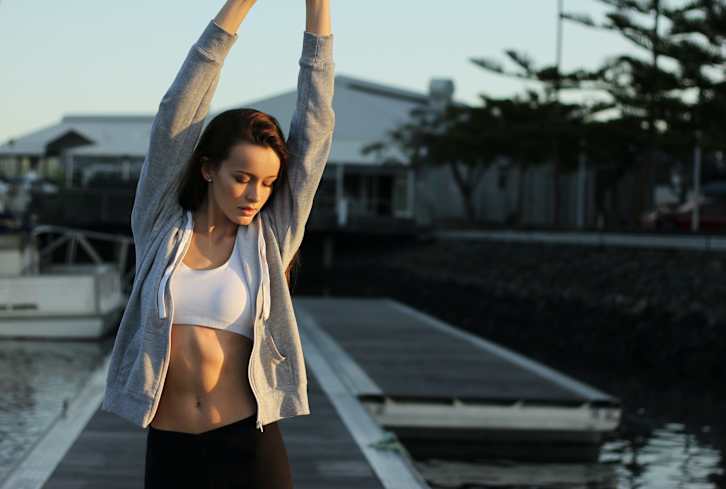Advertisement
7 Easy, Expert-Backed Exercises To Help Keep Your Eyes Sharp


By now, we know that exercising can help strengthen and grow our muscles. But does the same principle apply to our eyes?
Today's technology-oriented lifestyle has most adults stuck in front of the screen for at least eight hours a day (and that could just be work!). Add phone use or a nightly TV wind-down and that number can creep up to 12 hours.
And gazing intently (at anything) close up puts strain on your eyes. To help counter this and promote optimal eye health and longevity, many optometrists recommend certain eye exercises. But don't worry, these don't require hours at the gym to see results.
Here's what the experts want you to know.
What are eye exercises?
First and foremost, the eyes are an organ, not a muscle. So unlike muscle fibers that grow in response to exercise, eyes do not respond in the same way.
"None of the eye muscles need strengthening—they're all strong enough to do the job they need to do," says Jeffery Anshel, O.D., FAAO. "For example, the muscles on the outside of the eye, that move the eyes up and down and left and right are 200 times stronger than they need to be to move an eyeball."
So eye exercises—or more accurately eye techniques—are intended to help the eyes focus (aka control the muscles), stay flexible (move from looking up close to afar), and coordinate (which actually occurs in the brain).
Eye exercises can be useful 1for those with strained eyes (usually from looking at something closely for long periods), light sensitivity, motion sensitivity, and more.
So we tapped into three experts for their most recommended eye exercises:
The 20-20-20 rule
Anshel recommends that most heavy computer users follow the 20-20-20 rule: "Just take 20 seconds and look 20 feet away every 20 minutes."
It's easy to get lost in a rabbit hole when working away on the computer (as a writer, I know that all too well), and sometimes hours pass before you even look around.
Taking less than a minute to focus on something besides your screen every hour—and yes you can just close your eyes for 20 seconds—can help ease eye strain and maybe even signs of dry eyes.
Near-far focus shifting
Another technique Anshel recommends (and has even practiced himself) is often referred to as near-far focus shifting.
For this, you want to cover one eye and then look far away (it could be looking at the far end of the room you're in, for example). Focus on that spot until it's clear, and then look at something up close (it could be a hand or something at the edge of your desk) until it's clear.
Then look back at the far spot. Do this for around 12 reps. Once you've mastered the distance you started with, make your far spot even farther away.
"After age 40, our focusing ability decreases," notes Anshel. This exercise can help improve coordination between the eyes and the speed at which you're able to adjust your eyes2.
Concentration practice
Christine Tara Peterson, Ph.D., AHP, RYT, practitioner and researcher in Ayurveda and yoga, encourages people to try a simple concentration exercise.
"Start with holding a pen or other small object at arm's length and focus on it," she says. "Then, slowly move the object toward your nose, keeping your focus on it."
Stop when the object becomes blurry and then repeat 10 to 15 times.
Palming
If you want a relaxing escape without leaving your desk during the workday, consider palming.
Palming is a relaxation technique that involves covering your closed eyes with your palms.
"Create a warm, dark environment by cupping your hands over your eyes without putting pressure on them," says Peterson. "Take a few deep breaths and relax your eyes for a minute or two."
While your eyes get a nice break from light and up-close concentration, it's also an opportunity to briefly quiet your mind.
Figure eights
Marina Gurvich, O.D., recommends drawing a figure eight with your eyes.
To do this, stare at a blank wall in the distance (it shouldn't be blurry). "Imagine a figure eight on its side (like the infinity sign). Without moving the head, trace it with your eyes in one direction for a few seconds and then the other direction for a few seconds," she instructs.
Repeat this 10 times.
Flexing
This exercise may help stretch your eye muscles.
"Sit with your face looking straight ahead at a distance," says Gurvich. "Without moving the head, simply move the eyes up and hold for a few seconds, then down and hold for a few seconds."
Do this 10 times before doing this same sequence from left to right.
Clock circles
This exercise involves moving your eyes in a circular motion as if you're tracing the numbers of a clock.
Peterson emphasizes, "While there isn't strong empirical research to definitively establish the efficacy of clock circle eye exercises, I personally find in clinical practice and with myself that they help greatly with tired, heavy computer eyes and eye dryness from too much screen time."
Do these eye exercises work?
According to Gurvich, these exercises can be very effective. "The practice of vision therapy originated more than 150 years ago," she notes. "The eyes need training to build strength and flexibility for eye teaming and tracking to improve visual function and performance."
But Peterson emphasizes that the results may vary person to person depending on your individual needs and eye concerns.
While eye exercises are by no means a new concept, research is still trying to catch up and quantify the exact benefits of these techniques.
Other ways to improve eye health
In addition to trying eye exercises, there are a slew of other steps you can take to protect your vision and support eye health:
- Get an annual eye exam: According to the American Optometric Association, all adults (and children over 6) should have a yearly eye exam to monitor and assess ocular health and vision changes.
- Supplement as needed: Certain nutrients can significantly impact—and improve—eye health. These include carotenoids, omega-3s3, and maqui berry 4to name a few. mindbodygreen's eye health+ is specifically formulated with science-backed ingredients that increase eye hydration, reduce eye strain, and combat sensitivity to light.* Check out this guide for a full list of favorite eye health supplements.
- Wear sunglasses outside: Too much UV exposure can be damaging to the eyes. If you're outside (or even driving) for more than 15 to 30 minutes, make sure you have your shades on.
The takeaway
The eyes are designed to help us see things far away. Thus the strain of looking at things close up for extended periods can mess with your vision and brain.
Eye exercises can help combat some of the negative outcomes of these modern-day problems by helping your eyes focus and work together as a team. Talk with a health care provider if you have questions about which exercises may be most beneficial for the eye concerns you're experiencing.
These exercises just require a couple of minutes of your day and are a great addition to other daily eye care habits—like taking a targeted supplement and wearing sunglasses.
4 Sources

This Could Be The Missing Link For Lowering Blood Pressure
Jillian Kubala, M.S., R.D.

Can Creatine Boost Depression Treatment? Here's What The Research Says
Molly Knudsen, M.S., RDN

This Could Be The Missing Link For Lowering Blood Pressure
Jillian Kubala, M.S., R.D.

Can Creatine Boost Depression Treatment? Here's What The Research Says
Molly Knudsen, M.S., RDN

















